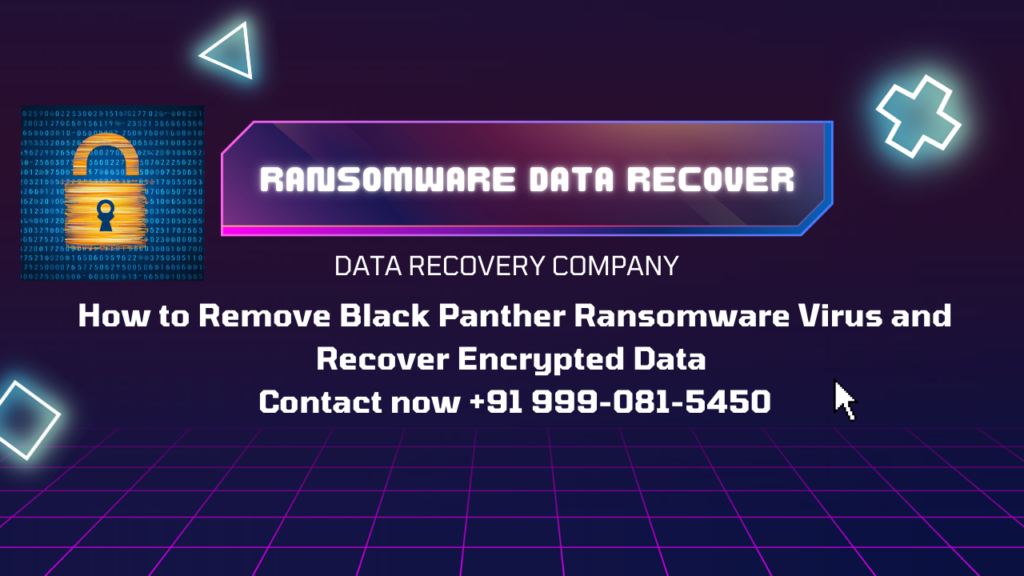
How to Remove Black Panther Ransomware Virus and Recover Encrypted Data: Black Panther Decryptor Process
Black Panther Ransomware : In today’s digital age, cybersecurity threats like ransomware have become increasingly sophisticated and damaging. One such threat is the Black Panther ransomware virus, known for its devastating impact on infected systems. This blog post will guide you through understanding, removing, and recovering from the Black Panther ransomware virus, and provide insights into the Black Panther decryptor process.
What is Black Panther Ransomware?
Black Panther ransomware is a type of malicious software designed to encrypt files on a victim’s computer, making them inaccessible. Once the files are encrypted, the ransomware demands a ransom payment in exchange for the decryption key needed to restore access to the affected files. This type of cyber attack can have severe consequences, including data loss, financial costs, and significant downtime for businesses.
How Does Black Panther Ransomware Work?
Infection Vector
Black Panther ransomware typically spreads through phishing emails, malicious attachments, or compromised websites. Once a user unknowingly downloads and executes the malicious file, the ransomware begins its encryption process.
Encryption Process
The ransomware utilizes advanced encryption algorithms to lock the victim’s files. Common file types targeted include documents, images, videos, and databases. After encryption, the ransomware appends a unique extension to the affected files, making it clear that they have been compromised.
Ransom Demand
A ransom note is then displayed, instructing the victim to pay a specified amount, often in cryptocurrency like Bitcoin, to receive the decryption key. The ransom demand can range from a few hundred to several thousand dollars, depending on the target.
Recognizing the Signs of a Black Panther Ransomware Infection
Identifying a ransomware infection early is crucial for minimizing damage. Here are some common signs of a Black Panther ransomware infection:
- Unusual file extensions: Encrypted files will have new, unfamiliar extensions.
- Ransom notes: Messages demanding payment will appear on your screen or in text files within affected directories.
- System performance issues: Your computer may become unusually slow or unresponsive.
- Inaccessible files: Attempting to open certain files results in error messages indicating that they are corrupted or inaccessible.
Step 1: Isolate the Infected System
To prevent the ransomware from spreading to other devices on your network, immediately disconnect the infected system from the internet and any shared drives or networks.
Step 2: Boot in Safe Mode
Restart your computer in Safe Mode to prevent the ransomware from actively running. This can be done by pressing the F8 key (or the appropriate key for your system) during startup and selecting Safe Mode from the boot menu.
Step 3: Use Anti-Malware Software
Download and run reputable anti-malware software to scan and remove the ransomware. Ensure that your anti-malware software is up-to-date with the latest virus definitions to effectively detect and eliminate the threat.
Step 4: Delete Suspicious Files
Manually search for and delete any suspicious files or programs that may have been installed around the time of the infection. Look for unfamiliar applications or files with unusual names and delete them.
Recovering Encrypted Data with Black Panther Decryptor
Understanding Decryption
Decryption is the process of converting encrypted data back into its original form. The Black Panther decryptor is a specialized tool designed to reverse the encryption caused by Black Panther ransomware.
Step 1: Obtain the Decryptor
The first step in the decryption process is to obtain a legitimate Black Panther decryptor tool. This can be provided by cybersecurity firms, anti-malware software companies, or law enforcement agencies. It is crucial to ensure that the decryptor is from a reliable source to avoid further complications.
Step 2: Follow Decryption Instructions
Each decryptor tool comes with specific instructions for use. Follow these instructions carefully to avoid damaging your files further. This often involves running the decryptor on the infected system and allowing it to scan and decrypt the affected files.
Step 3: Restore from Backups
If decryption is not possible, restoring from backups is the next best option. Regularly backing up your data is essential for minimizing the impact of ransomware attacks. Ensure that your backups are stored offline or on a separate network to protect them from being compromised.
Preventing Future Ransomware Infections
Regular Software Updates
Keeping your operating system and all software up-to-date is crucial for protecting against ransomware attacks. Software updates often include security patches that address vulnerabilities exploited by ransomware.
Use Strong Passwords
Implement strong, unique passwords for all accounts and systems. Use a combination of letters, numbers, and special characters to create secure passwords. Consider using a password manager to keep track of your credentials.
Enable Multi-Factor Authentication
Multi-factor authentication (MFA) adds an extra layer of security by requiring additional verification beyond just a password. This can significantly reduce the risk of unauthorized access to your systems.
Educate Employees
Educate employees about the dangers of ransomware and how to recognize phishing attempts. Regular training sessions can help ensure that everyone in your organization is vigilant and prepared to handle potential threats.
Regular Data Backups
Regularly back up your data to an external drive or cloud storage service. Ensure that backups are performed frequently and that the backup files are stored in a secure, offline location.

